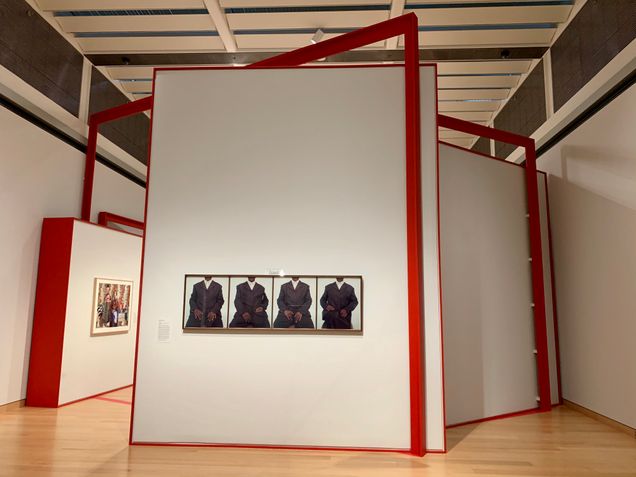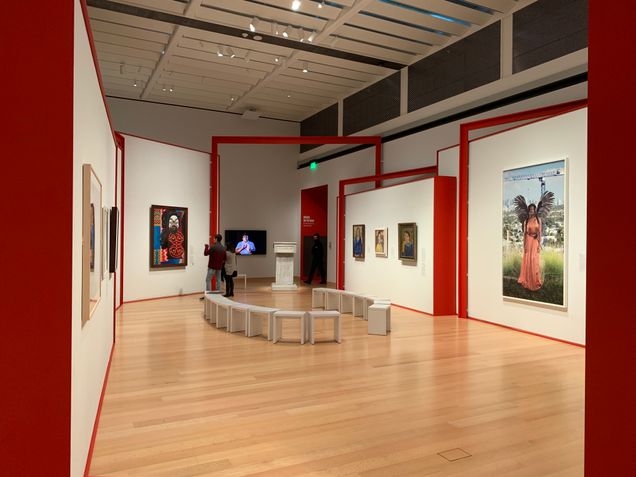Women Take the Floor

Museum of Fine Arts, Boston
September 13, 2019 – May 3, 2021
Extreme times call for extreme heroines.
-Betye Saar
At the Museum of Fine Arts, Boston, visitors are drawn into the third level of the Art of the Americas Wing by a number of converging speech bubbles featuring provocative statements by radical women thinkers and makers, including 93-year old Betye Saar, whose work is finally getting attention from major museums.[1] This provides a fitting entry point for the exhibition Women Take the Floor, which contends with “the dominant history of 20th-century American art by focusing on the overlooked and underrepresented work and stories of women artists.”[2]

As one makes one’s way into the main gallery space, comprised of portraits of women by women, one sees Alice Neel’s painting, Linda Nochlin and Daisy (1973) (Fig. 1). This encounter sets the tone of what’s to come.[3] An accompanying video features Nochlin discussing the portrait, allowing her voice as a feminist art historian to flow through the exhibition. She was well known for her 1971 essay “Why Have There Been No Great Women Artists?,” where she discusses possible answers for said gender disparity, including issues of class and institutional discrimination. In spite of these forces, Nochlin argues that women can capitalize on their outsider position to unveil the fragility of the establishment.[4] As Lorna Simpson’s challenge to stereotypical notions of gender makes clear, the hegemonic narrative is in an ongoing process of destabilization of which this exhibition aims to be a part (Fig. 2).

Organized on the occasion of the 100th anniversary of the 19th Amendment to the U.S. Constitution, which granted white American women the right to vote, and the 150th anniversary of the MFA’s founding, Women Take the Floor signals the museum’s recognition of its own inconsistent history of supporting women artists. Mining the collection, Weems Senior Curator of American Decorative Arts and Sculpture, Nonie Gadsen and her curatorial team position the show as a necessary corrective to previous exhibitions and collecting practices that have neglected women artists. In keeping with the museum’s larger mission to advance equity, diversity, and inclusion, museum staff selected more than two hundred works by nearly one hundred women from the last century, many of them historically overlooked and underrepresented.
Moving further into the core gallery, just behind Simpson’s “female” portraits, viewers are struck by a fractured installation of walls of uneven size—far from the traditional white cube—framed in vivid red paint (Fig. 3). They recall the provocative graphic aesthetic of Barbara Kruger, who is known for layering white Futura Bold typeface against red text bars over found imagery.
Yet Kruger’s Untitled (You Construct Intricate Rituals) (1981), which entered the MFA’s collection in 1993, is strangely absent from this reinstallation—or “takeover”—which seems like a missed opportunity given the MFA’s appropriation of her iconic aesthetic. Highlights of this room include Frida Kahlo’s dignified double-portrait of Mexican-working class women and Andrea Bowers’ large-scale photograph of black trans-feminist activist CeCe McDonald.

The dynamism of “Women Depicting Women” is downplayed in the six other exhibition galleries, which, at times, explore overfamiliar themes. There are several paintings by well-known artist Georgia O’Keeffe; large-scale canvases by women Abstract Expressionist painters; and gendered landscapes. Perhaps more engrossing are the fiber sculptures by Lenore Tawney and Olga de Amaral; prints that artists including Kiki Smith and Lee Bontecou made at Tatyana Grosman’s lithography workshop, Universal Limited Art Editions; and the juxtaposition of Carmen Herrera’s geometric abstract painting, Blanco y Verde (1959), with the gown that it inspired (Fig. 4). One of the show’s greatest strengths is its presentation of works in various media, from paintings, prints, and photographs to ceramics, textiles, furniture, and jewelry, reflecting the diversity of approaches women have taken in the decades following the campaign for women’s suffrage.
As one exits the exhibition, they may notice Alexander Calder’s Mobile blanc (Fig. 5). Made in 1971 — the same year Nochlin published her famous essay – it looms high above the space, quietly propelled by air currents. One could chalk this up, of course, to the challenges of de-installing a Calder mobile, but some might find its intrusion quite curious, and a little unwelcome.[5] Its monumentality, however, is defused by Alice Neel, Lorna Simpson, and Louise Bourgeois, whose artistic achievements “take the floor” and the walls in what was (and still is) a male-defined domain. As Nonie Gadsden explained at the MFA’s press preview, the phrase “Nevertheless, she persisted” applies to every woman artist who persists in spite of numerous obstacles. Women Take the Floor succeeds in showcasing not merely their creative vision but also their unapologetic presence.[6]

Constanza Robles and Althea Ruoppo
____________________
[1]In a recent interview with Holland Cotter, Betye Saar, whose work is the subject of two concurrent solo exhibitions at the Museum of Modern Art in New York and the Los Angeles County Museum of Art, declared, “…it’s about time! “I’ve had to wait till I’m practically 100.” Holland Cotter, “‘It’s About Time!’ Betye Saar’s Long Climb to the Summit,” New York Times, September 4, 2019. https://www.nytimes.com/2019/09/04/arts/design/betye-saar.html. Accessed October 21, 2019.
[2]Museum of Fine Arts, Boston, Women Take the Floor, https://www.mfa.org/exhibition/women-take-the-floor. Accessed October 21, 2019.
[3]Broad in scope and ambitious in aim, Women Take the Floor is divided into seven thematic sections over just as many galleries: “Women Depicting Women: Her Vision, Her Voice;” “Women of Action;” “Women Publish Women: The Print Boom;” “Women on the Move: Art and Design in the 1920s and ’30s;” “Women and Abstraction at Midcentury;” “No Man’s Land;” and “Beyond the Loom: Fiber as Sculpture / Subversive Threads.”
[4]Linda Nochlin. “Why have there been no great women artists?” In Hess, Thomas, and Baker, Elizabeth. Art and Sexual Politics; Women’s Liberation, Women Artists, and Art History. Art News Series (New York: Macmillan, 1973), 37.
[5]In 1943, the Museum of Modern Art in New York hosted Alexander Calder: Sculptures and Constructions, making Calder, then just 45 years old, the youngest artist at that point to have been given a retrospective there.
[6]The authors would like to thank the Museum of Fine Arts, Boston, for providing the opportunity to attend the season preview on September 12, 2019.